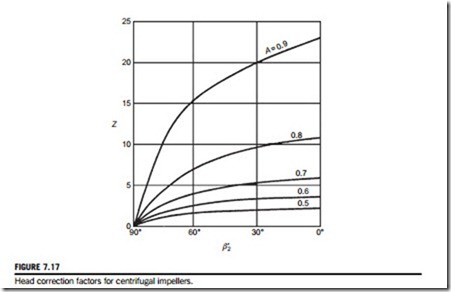Head increase of a centrifugal pump
The actual delivered head H, measured as the head difference between the inlet and the outlet flanges of the pump and sometimes called the manometric head, is less than the ideal head Hi defined in Eq. (7.4) by the amount of the internal losses. The hydraulic efficiency of the pump is defined as
In general, centrifugal pump impellers have between 5 and 12 vanes inclined backward to the direction of rotation, as suggested in Figure 7.5, with a vane tip angle β0 of between 50o and 70o.
A knowledge of blade number, β0 and φ2 (usually small and on the order of 0.1), generally enables σ to be found using the Busemann formula. The effect of slip, it should be noted, causes the relative flow angle β2 to become larger than the vane tip angle β0 .
EXAMPLE 7.3
A centrifugal pump delivers 0.1 m3/s of water at a rotational speed of 1200 rev/min. The impel- ler has seven vanes, which lean backward to the direction of rotation such that the vane tip angle β0 o 2 is 50 . The impeller has an external diameter of 0.4 m, an internal diameter of 0.2 m, and an axial width of 31.7 mm. Assuming that the diffuser efficiency is 51.5%, that the impeller head losses are 10% of the ideal head rise, and that the diffuser exit is 0.15 m in diameter, estimate the slip factor, the manometric head, and the hydraulic efficiency.



